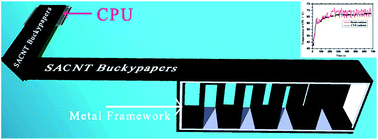Excellent heat dissipation properties of the super-aligned carbon nanotube films†
Abstract
Carbon nanotubes (CNTs) and related macroscopic materials could be widely used as thermal management materials because of their high thermal conductivity and light weight at ambient temperature. Meanwhile, heat dissipation properties also play a significant role in applications of thermal management materials. Measurement of the heat dissipation properties of different layers of super-aligned carbon nanotube (SACNT) films has been reported in this work. The equilibrium temperature of a hot copper plate could be reduced about 13.3% by the multilayer SACNT films. This feature indicates that multilayer SACNT films have very good heat dissipation properties, leading to the appearance of novel light-weight and high-performance heat dissipation materials. Furthermore, the radiative heat dissipation and the natural convective heat dissipation of the SACNT films are respectively calculated by the measurement of surface emissivity. It is found that the radiative heat dissipation of multilayer SACNT films play an important role in the total heat dissipation properties. This advantage would be more promising when they are applied in aerospace science and technology. It is further found that the SACNT films have much better natural convective heat dissipation properties than the several-layer graphene. In view of the high thermal conductivity and low density of compacted multilayer SACNT films reported in our previous work, a novel CPU-radiator made of compacted multilayer SACNT films has been presented to pave the way for practical thermal management applications of the compacted SACNT films. In addition to this application, our results reported here also indicate that the SACNT films would have a variety of applications such as shells of portable electronic devices and thermal management coatings of aerospace devices.


 Please wait while we load your content...
Please wait while we load your content...